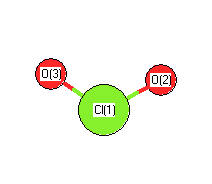Vibrational Frequencies calculated at B2PLYP=FULL/cc-pV(T+d)Z
| Mode Number |
Symmetry |
Frequency
(cm-1) |
Scaled Frequency
(cm-1) |
IR Intensities
(km mol-1) |
Raman Act
(Å4/u) |
Dep P |
Dep U |
|---|
| 1 |
A1 |
957 |
957 |
13.31 |
649.72 |
0.37 |
0.54 |
| 2 |
A1 |
443 |
443 |
15.17 |
3.52 |
0.72 |
0.84 |
| 3 |
B2 |
1118 |
1118 |
148.13 |
0.43 |
0.75 |
0.86 |
Unscaled Zero Point Vibrational Energy (zpe) 1259.0 cm
-1
Scaled (by 1) Zero Point Vibrational Energy (zpe) 1259.0 cm
-1
See section
III.C.1 List or set vibrational scaling factors
to change the scale factors used here.
See section
III.C.2
Calculate a vibrational scaling factor for a given set of molecules
to determine the least squares best scaling factor.
